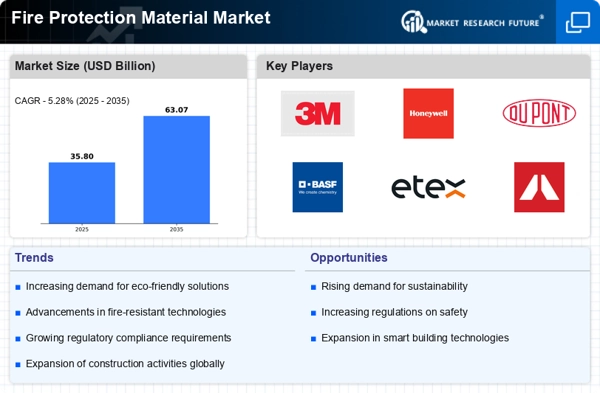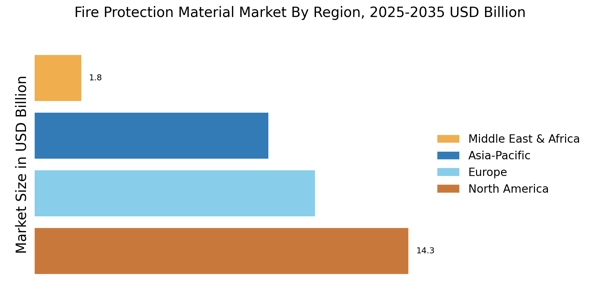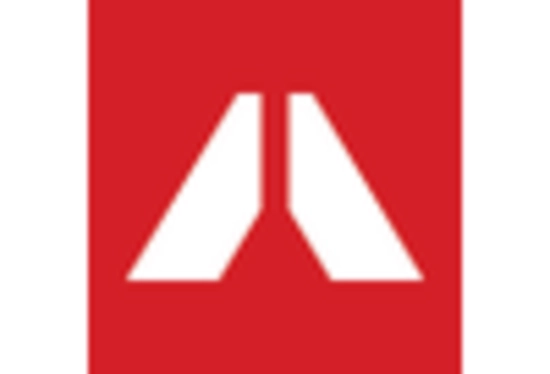Growth in Industrial Sector
The growth in the industrial sector is a pivotal driver for the Fire Protection Material Market. As industries expand and diversify, the need for robust fire protection measures becomes increasingly critical. In 2025, the industrial sector is projected to grow by approximately 4%, leading to heightened demand for fire protection materials tailored to specific industrial applications. Industries such as manufacturing, oil and gas, and chemicals are particularly vulnerable to fire hazards, necessitating the use of specialized fire-resistant materials. This growth is prompting manufacturers to innovate and offer customized solutions that cater to the unique needs of various industries. Consequently, the Fire Protection Material Market is likely to witness a surge in demand as industries prioritize safety and compliance with fire protection standards.
Rising Awareness of Fire Safety
The Fire Protection Material Market is significantly influenced by the rising awareness of fire safety among consumers and businesses. Educational campaigns and media coverage have heightened public consciousness regarding the risks associated with fire hazards. As a result, there is an increasing demand for fire protection materials that comply with safety standards. In 2025, it is estimated that the fire safety equipment market will reach a valuation of over 30 billion, indicating a robust growth trajectory. This heightened awareness is prompting both residential and commercial sectors to invest in fire protection solutions, thereby driving the Fire Protection Material Market. Furthermore, organizations are increasingly prioritizing fire safety training and compliance, which further propels the demand for effective fire protection materials.
Stringent Regulatory Frameworks
The Fire Protection Material Market is significantly impacted by stringent regulatory frameworks that govern fire safety standards. Governments and regulatory bodies are increasingly implementing laws that require the use of fire-resistant materials in construction and manufacturing processes. In 2025, it is anticipated that compliance with these regulations will drive a substantial portion of the market, as businesses seek to avoid penalties and ensure safety. The enforcement of these regulations is particularly evident in sectors such as healthcare, education, and hospitality, where the risk of fire hazards is higher. As a result, companies are compelled to invest in fire protection materials that meet these regulatory requirements, thereby propelling the growth of the Fire Protection Material Market. This trend underscores the importance of compliance in shaping market dynamics.
Increasing Construction Activities
The Fire Protection Material Market is experiencing a surge due to the increasing construction activities across various sectors. As urbanization accelerates, the demand for residential, commercial, and industrial buildings rises, necessitating effective fire protection solutions. In 2025, the construction sector is projected to grow by approximately 5%, which directly influences the demand for fire protection materials. This growth is particularly evident in regions where building codes are becoming more stringent, thereby mandating the use of advanced fire-resistant materials. Consequently, manufacturers are innovating to meet these requirements, leading to a more competitive landscape within the Fire Protection Material Market. The integration of fire protection materials in new constructions not only enhances safety but also adds value to properties, making it a critical driver in the market.
Technological Innovations in Fire Protection
Technological innovations are reshaping the Fire Protection Material Market, leading to the development of advanced materials that offer superior fire resistance. Innovations such as intumescent coatings, fire-resistant glass, and advanced insulation materials are gaining traction. These materials not only enhance safety but also improve energy efficiency, appealing to environmentally conscious consumers. In 2025, the market for advanced fire protection materials is expected to grow at a compound annual growth rate of 6%, driven by these technological advancements. Manufacturers are investing in research and development to create products that meet evolving safety standards and consumer preferences. This trend indicates a shift towards more sophisticated fire protection solutions, which is likely to bolster the Fire Protection Material Market in the coming years.


















Leave a Comment